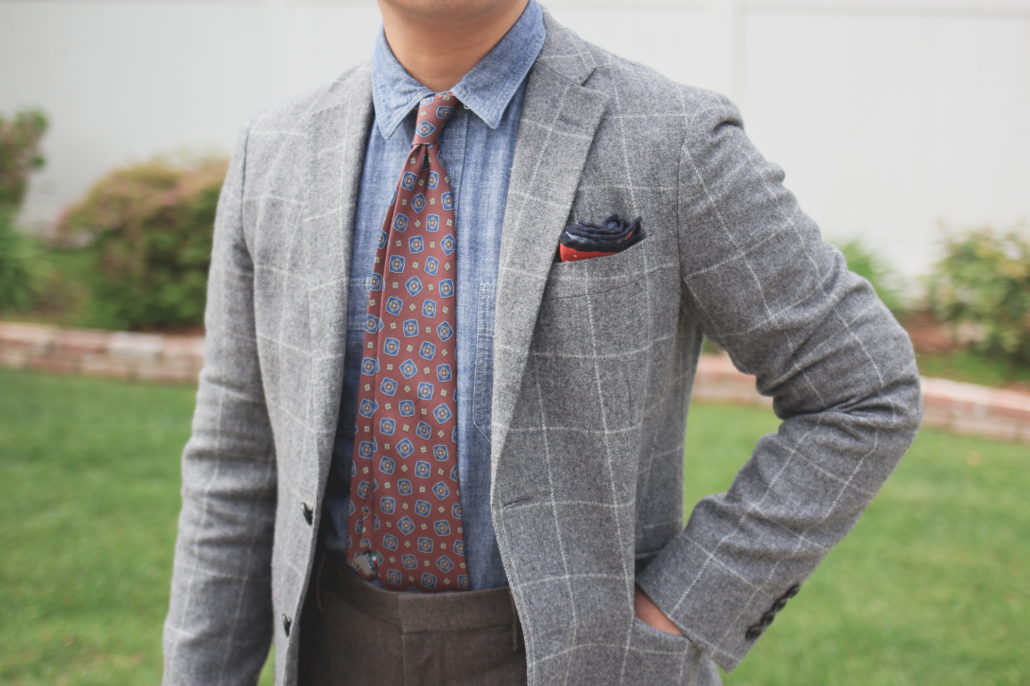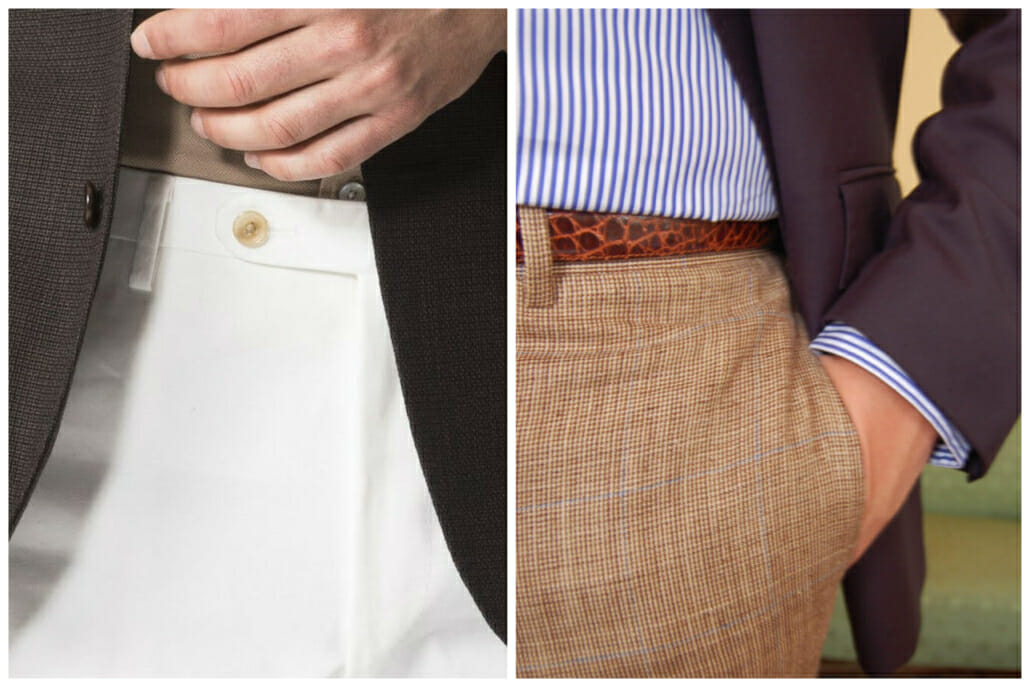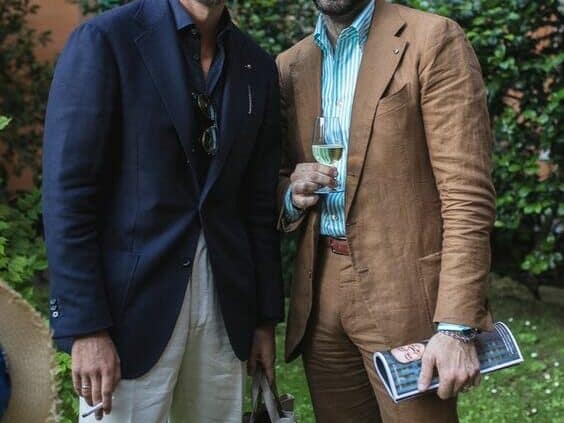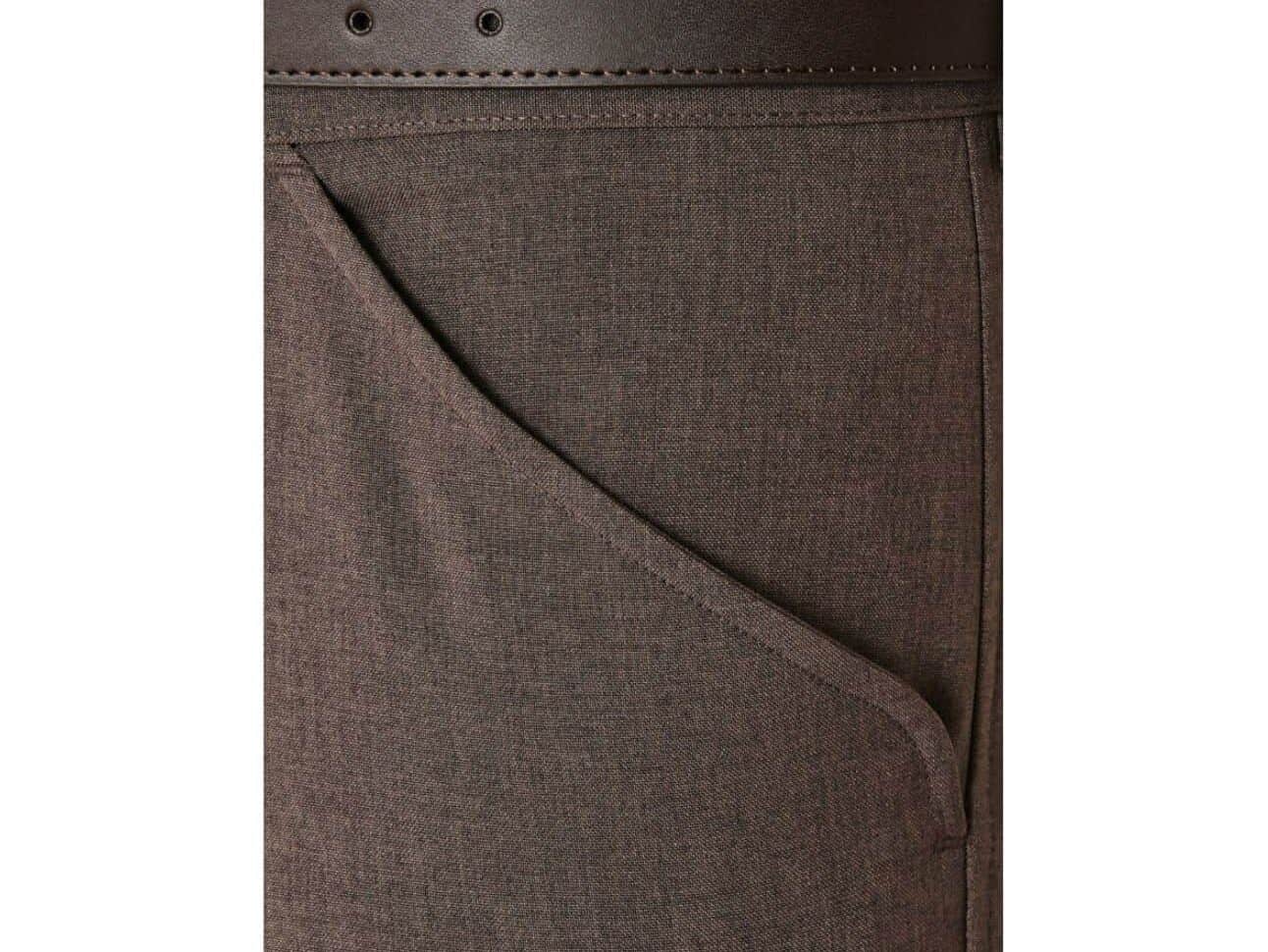So much effort goes into the finding the perfect jacket that if there is one garment men tend to neglect when they pick out a suit, it’s the pants. It’s time to give the sartorial features of pants their due.
It’s understandable why the anatomy of the suit jacket, with the lapels, the pocket style, and the buttons, among many other features, demands the most attention. But, the pants are crucial to providing balance and definition to the rest of the outfit, and a misstep can throw off the entire look. Trousers also contain various features from top to bottom, waistband to hem, that are important to consider for fit and appearance whether you are buying them as part of a suit or on their own as a pair of casual chinos.
Features of a Pair of Pants – 1. Waistband
Starting at the top, pants most commonly feature a waistband. The waistband is a thin strip of fabric that wraps around the waist and features the some of the securing mechanisms needed to hold them on the body, namely a button or hooks.

The waistband can vary in terms of width, from thin to wide, though the standard is between 1-2″ wide.
Occasionally, especially with MTM or bespoke trousers, you may find a pair without a waistband, which is often referred to as a continuous waistband.
2. Belt Loops
Attached to the waistband are the belt loops, which hold the belt in place around the waist. It is traditionally said that pants with belt loops should always be worn with a belt; otherwise, it looks like you just forgot to put it on. However, going beltless is popular for a casual sprezzatura look.

On custom-made or higher-end dress pants you will also find the related prong keeper, a tiny loop of fabric at the front center, that is designed to hold the prong of your belt buckle in place like the keeper on the back of a tie. Its purpose is to keep your buckle centered, preventing your belt from rotating away from the center as you go about your daily activities. Because they’re made of a different material (leather) in a different color than your shirt or pants, they interrupt the vertical flow of your outfit, and leather is a casual material if you are wearing tailoring.
3. Suspender Buttons
Though you will almost never find them off the rack, some pants are tailored with suspenders buttons on the inside of the waistband. These pants tend to be higher in the rise and pleated, as the suspenders help pull the pants upward rather than inward, creating a smooth line down the leg and pleats.
In terms of design, most pants are designed to be used with either a belt or suspenders, but not both. Side adjusters, discussed further below, can be tailored on pants meant to be worn with suspenders because they can help adjust the waist width while not bearing the burden of holding up one’s trousers entirely.

Flannel pants with side adjusters
Neopolitan tailors occasionally will tailor both suspender buttons and belt loops for the sake of sprezzatura, but it is neither a classic look nor all that practical since a pair of pants will look best when tailored for either a belt or suspenders rather than both.

4. Side Adjusters
For reasons of greater formality and uninterrupted lines, some men prefer trousers with side adjusters. These are usually small buckles, one at each hip, attached to cloth tab or strap that enable you to cinch the waist an inch or so on each side.
The adjuster can be placed center of the waistband (as shown above) or lower, on the seam that joins the waistband to the rest of the pants.

Alternatively, you can find adjusters with buttons rather than buckles though these do not have the same range of possible adjustments–you can select either button one or button two–and are slightly less formal. The adjusters are hidden and the clean expanse of cloth they create at the front waistband makes pants more formal. Thus, side adjusters are found on formal wear and in better suits. Similarly, on bespoke trousers, if anything, side adjusters are used because a belt would suggest that the pants are not properly fitted, which should not be the case if they are custom made for you. At the opposite extreme, a waistband can also contain a drawstring or elastic band, though these would be reserved for pajamas and exercise pants; don’t be fooled by SuitSupply ads showing men wearing them with sport coats!
A belt also directs the eye to your waistline, so if you have what the Italians call a balconetta there, pants with side adjusters can de-emphasize your belly.

Because the belt acts like a strong dividing line between your top and bottom halves, if you have legs that are short, try side adjusters to create more of a continuous flow, elongating your figure. On the other hand, if you have really long legs, pants with a belt can help balance you out.
5. After-Dinner Split
There are a couple of other useful details at the waistline. One is the charmingly named “after-dinner split.” This is a split in of the material at the center back of the waistband held together by loose slip stitching similar to what you’d see on the back of a tie, sometimes accompanied by a V-shaped notch. The name suggests that it helps accommodate the expansion of your stomach if you eat a large meal. However, its real purpose is to allow more movement of the fabric at the waist, especially when you sit. The effect seems to be subtle, but having one is a hallmark of attention to detail.

6. Waist Curtain
Lastly, on the inside of your waistband, you may have a waist curtain. It’s essentially a strip of lining that runs the full circumference of the waistband. Usually, it’s secured along the top of the waistband but can be lifted up from the bottom to reveal the underlying materials of the waistband construction.

On its own, its functional purpose is minimal, but it is another sign of quality finishing. When the waistband is rubberized (i.e., it features a narrower glued on rubber strip) there may be a greater effect, which is to help keep your shirt tucked in. The rubber provides friction and grip that helps secure the fabric of your shirt. I have not empirically tested its effectiveness compared to a waist curtain without rubber, but you’re welcome to try and report your results.

7. The Rise
Below the waistband is the area called the rise, measured from the seam at the bottom of the crotch to the waistband. This may be in the range of 9-13 inches depending on the size of the pants and whether it is low-, mid-, or high-rise. For a while now, low-rise trousers have been in fashion, meaning the pants sit around your hip area. Rise plays a significant role in determining the visual proportions of your body.
Low-rise pants make your upper body look longer and your legs shorter, as your pants simply do not go up that high on your body. Therefore, a low-rise can help balance out the appearance of men with long legs. In contrast, high-rise trousers sit at your true waist, which is around your belly button. Because there’s more fabric between the waist and crotch, they visually elongate your legs, so high-rise pants are ideal for men with shorter legs. Like pleats (discussed below), a high rise is often ridiculed for their association with granddads wearing their pants hiked up to right below the nipples.

From my perspective, high-waisted pants look best if you are wearing a suit jacket, blazer, or sports coat, especially closed. In this situation, they are ideal because their height prevents either the bottom of your tie or the lower part of your shirt from showing between the lower button of your jacket and the waistband of your pants. Ideally, there should be a clean, uninterrupted transition from the jacket to the pants; a high waist ensures this. On the other hand, if you open your jacket, high-waisted pants risk making your chest look concave or sunken and also shorten your torso. The solution is therefore either to go with a moderately high or mid-rise pair of pants or to keep your jacket closed.

High-rise trousers create more of a classic or vintage look, and fashion illustrations from the Golden Age of menswear between the 1920s-50s show this as the default. You’ll also notice that neckties were considerably shorter, so if you wear high-rise pants you’ll either need to buy shorter ties or vintage ties, tuck them into your waistband or wear them longer than your waistband, but more in the sprezzatura style than Donald Trump.
8. Pleats (Or a Lack Thereof)
We’ve previously spoken about pleated pants and whether you should wear them in another article, so check that out for a more in-depth discussion. In brief, pleats are folds of fabric in the trouser rise. On flat-front trousers, as the name states, the fabric in this area is smooth. Pleats can either be forward facing, in which the folded fabric points inward, toward the fly of your pants, or reverse—pointing in the direction of the pockets. The British style generally favors inward-facing pleats whereas pants in a more Italian, specifically Neapolitan, style usually face outward. In terms of which is better, forward pleats usually receive less criticism as they tend to remain flat, while outward ones may open and stay open, resulting in ballooning fabric. The number of pleats that you have can vary: usually, one or two, though some men have experimented with three and even four pleats.

Pleats add mass and visual impact to the area of the rise. They can provide more comfort than a flat rise, especially if you carry weight in your abdomen, because the extra fabric there expands slightly as you move around, sit down or get up. Pleats also continue the crease that runs up the middle of each pants leg if you have dress pants on, which enhances the sharp and polished look.
9. The Seat

On the opposite side of the rise is your seat, where your rear end is. There isn’t much to say about pants construction here except for the various pocket options. Usually, you have two rear pockets on the seat, though these can either be welt pockets or welts with a single button on each. This gives you a clean rear seat. Any other possibility–flapped or patch pockets–would be present only on casual pants. Whatever the design, these rear pockets are useless for the most part since loading them with anything more than a small piece of paper and perhaps a pen will make it annoying to sit down. On a side note, if you get your waist let out by a tailor to make it larger, there will usually be some cloth in the seat area to let out as well; doing both at the same time helps with comfort and maintaining a clean rear view of your pants.
10. Front Pockets
Continuing the discussion of pockets, you will most likely have two of them on the front of any pair of pants. By far, the most common pocket style on trousers is slant pockets.
David Gandy in mid gray flannel with a DB vest and navy pants with slant pockets
As the name implies, these are cut on an angle, enabling the wearer to slide his hands into them easily.

Other rarer pocket forms are completely vertical and frogmouth pockets. The latter are named for their resemblance to the mouth of a frog. In the sense that these are oriented horizontally across the front of the trouser, they are the opposite of the vertical slit pocket. As such, they also really make the pockets a visible feature of the pants. Frogmouth pockets go with flat-front trousers as they would interfere with pleats.

If you’ve owned a pair of jeans, you are likely familiar with the coin pocket, a small, seemingly useless pocket that nests inside the larger one on the right front. Originally, it was developed by Levi-Strauss to enable men to carry their pocket watches while wearing denim. Today, in the era of wristwatches, this pocket has become vestigial, something more for a traditional aesthetic than any real function, though some men store things like coins, mints, or a condom in it. Along with the two front and two back pockets, the coin pocket is responsible for the term “five-pocket pants.” However, an added coin pockets can appear in pants that are more formal than jeans too, such as summer chinos.

11. The Fly and Front Closure
In order to get your pants on and off, you need to have a means of opening and closing them. This work is done by the fly and the button closures on the front of the waistband. The default for the latter is a single button, but on higher-end trousers, you’ll find an extended tab that tucks into a loop and is fastened off center. On pants that are meant to be rakish (Neapolitan, of course), you may find an elaborate double tab with two buttons. An equally ornate closure is available in British tailoring too, via the famous Gurkha trouser, a military-inspired garment with a long strap that buckles to close.

The front zipper is usually a standard and therefore very forgettable detail on a pair of pants. However, more fancy designs can feature a button fly as well as an elaborate system of a flap (sometimes called a French bearer) and inner buttons to fasten up the pants. In some cases, these can seem like overkill in keeping your pants closed and holding in your junk, but they are more a sign of the tailor’s time commitment and effort than a functional necessity.

12. Leg Cut
The legs on a pair of pants can be straight or tapered, wide or slim. For a sharp appearance, some tapering should occur, meaning the legs should get gradually more narrow as they move toward the bottom. This can happen top to bottom or start closer to the knee, which is an important consideration if you have large thighs. In recent years, slim legs have been in fashion, and, to some extent, they have always been part of the classic Italian style. As a guideline for future purchases, measure the bottom leg opening of a pair of pants that fit you well along with the width at the approximate location of the knee and thigh.

13. Lining
Legs may also be lined on the inside, either down to the thigh or fully, especially if the pants are a light color or one that is either sheer or rough–summer fresco cloth is both. The lining prevents your skin and underwear from showing through and also protects your skin from abrasion. The trade-off is that the lining makes you hotter in summer, reducing the cooling effect of the material.
The visible surface of the legs also can give you a strong indication of whether the pants are casual or formal. If there is a sharply defined crease down the center of the leg, the trousers are formal, but if they are flat, they are more casual. The presence of a visible seam down the inside of the leg also is a sign of casual style, seen on chinos and jeans.

14. Cuffs, AKA Turn-Ups
If you’re from North America and hear someone mention “turn-ups” in relation to pants, rest assured they’re not talking about vegetables but about the British term for trouser cuffs. Cuffs make a pair of pants less formal, probably because they add more ornamentation, and usually more ornamentation means less formality. Thus, you won’t see cuffs on a tux or even most business suits. For suits that are a bit more casual, like flannels or linen, you can get away with cuffs, usually in conjunction with other casual elements, like patch pockets on the jacket. Cuffs on pants are not a minor detail as they are immediately noticed and lend “weight” to the bottoms of the legs. In this way, they have the effect of visually shortening your legs. So, if you are tall or have long legs and want to balance out your appearance, cuffs may be for you. Shorter men should generally avoid them.

Cuffs look best with pants that have legs that are wider rather than those with small leg openings. I personally prefer a clean leg and have cuffs on only one pair of pants—summer linens; these are lightweight and, given the nature of linen, are prone to folds and creases and do not cling closely to my legs. All of these are the qualities that make for good air circulation while inviting a cuff to weigh the legs down a bit. A comparable cold weather fabric that works well with cuffs would be a light, soft corduroy, which has a similar potential to billow. When choosing trousers with cuffs, two things are essential. First, the pants should have no break. Wearing cuffs with a pants break appears sloppy, as the heavier cuff fabric pools around your ankles and over your shoes, making you look like a tramp or hobo. Secondly, the cuffs should not be too tall, usually around 1.5-2 inches or a maximum of 5 centimeters high. A side effect of cuffs is that some debris can get trapped in them from daily wear. This is why some cuffs are designed with a hidden button closure that enables you to open and close the cuffs to clean them out.

If you wear flat-front pants, cuffs are entirely optional. However, if you wear pleats, you would usually go with cuffs to counterbalance the pleats, both visually and in terms of lending actual physical weight to balance the pulling of pleats in the area of the rise.
Conclusion
Clearly, the features that make up a pair of pants are more than an afterthought. Some are practical, like side adjusters, while others, like waist curtain details, are hallmarks of a tailor’s attention. Knowing about them gives you a new appreciation of what goes into the construction of garments, something we often take for granted. You also have the details you need when figuring out what to choose for custom-made trousers. What features are a must-have for you? Share in the Comments section below.




Another great article!
I believe Sean Connery’s trousers are Daks tops. The adjuster goes through the rear waist band and has buttons on both sides. Similar to side adjusters, but not stitched to the waist band. I’ve been trying to find a tailor who understands and makes these to no avail (at least here in the Colonies).
The waist construction you are describing also has elastic in the middle. If you understand how it is made draw a pattern for it and take it to a tailor to have it made for you. The only problem I can see is the extra fabric needed for the ends. I used to have a pair of dress pants that were off-the-rack and had this detail.
Far too many of the pictures in the article show pants that are too tight through the crotch and thighs. The pegged pants from the 1960s fit better than these pants.
The photos showing a necktie tucked into the waistband look terrible. No class.
Dr Lee,
A well cut pair of trousers can do much to flatter a man of any proportion .
On each of those made by my tailor he includes a hand sewn seem around 1/4″ wide down the outside leg . Adds a nice finish .
Regarding custom features:
I make my own pants or trousers most of them in a western cut. This means that the belt loops when used are wider and have an arrow-head shape with a contrasting welt on the edge of the loop. I prefer the waistband style that is made from the fabric of the trousers and is not a separate sewn on piece (high-waisted). I also incorporate a long pocket curtain that lines the crotch and seat area for more comfortable horseback riding. The pocket curtain is akin to a loose pair of shorts incorporated into the trousers. I use front side inseam pocket openings and bound button closed rear pockets. The pockets are deeper than you would normally find. The front pockets will easily accommodate the larger mobile phones without digging into your body when seated. Pant’s legs are tapered but are wide enough at the bottom to cover a pair of boots. The bottom of the pant rests on the boot with little to no break. For colors, I prefer summer weight wool in grey, navy blue, black, blue-grey, or charcoal. I choose these colors because I have had my colors done and these are the best for my skin color. If there are woven patterns in the fabric they have to be subtle and the primary pattern or predominant color in a stripe must be vertical. Trousers must match the jacket. I am attempting to tailor a mid-thigh formal western wear suit jacket to match two pairs of my trousers; one with belt loops and one for suspenders. I am not a re-enactor. I have tried to get a western style suit made to fit but the few custom tailors that can make western style clothing seem to have retired. I make my own dress shirts too, though I am considering starting a manufactured line in the USA; off-the-rack and custom.
Fascinating article (but I miss not having a video to go with it).
Thank you GG.
Interesting and well-detailed. Can’t wait for Ralph to make n upload d video.
Photo 1 top photo………….top half outfit OK, bottom porblems. Cut of trousers not flattering, cuff/turn ups much to exagerated, not sure from photo re colour combo of jacket and trousers or textures of each.
Photo 5……. forward pleats and continous (Hollywood) waistband most elegant/attractive trousers. Could also have waistband and side adjusters and remain just as elegant.
Photo 6……..belt loops for casual trousers only
Photo 10……Salvatore Ambrosi…trouser much to slim at the hem. looks commical on him. Same or slightly higher rise together with fuller cut leg would enhance his overall look and height.
Photo 14….Urkel….strictly has a commic effect and that sadley diminishes the perception of pleted trousers.
Thanks for helping me understand that it would be best to choose the pair of pants that fit well along the bottom of the leg while at the right length until the ankle. I guess I really need to bring my husband when I buy him one. This was supposed to be a surprise for him on his 35th birthday, but it would be best to buy the right fitting for him.